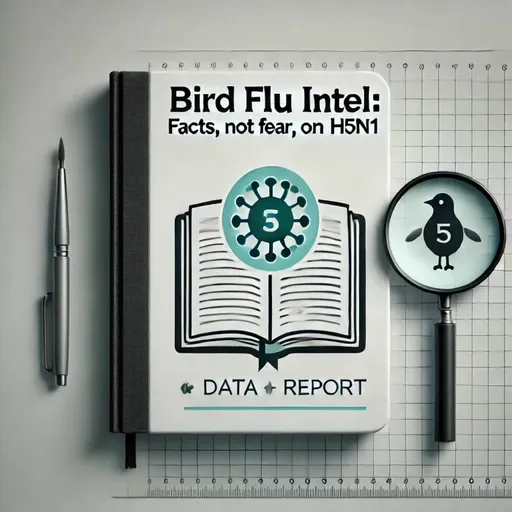
17 September 2025
H5N1 Bird Flu: Expert Insights Debunk Myths and Provide Essential Safety Information for the Public
Bird Flu Intel: Facts, Not Fear, on H5N1
About
Bird Flu Intel: Facts, Not Fear, on H5N1
Welcome to Bird Flu Intel. I'm your host, and today we're separating fact from fiction about H5N1 avian influenza.
Let's tackle four dangerous misconceptions circulating online.
Myth One: H5N1 spreads easily between humans like COVID-19.
The truth? The University of Florida reports that at least 70 people in the U.S. have tested positive for bird flu since 2022, with no known person-to-person transmission. Most cases occurred in agricultural workers with direct animal contact. This virus requires intimate exposure to infected animals, not casual human interaction.
Myth Two: All H5N1 infections are deadly.
Reality check: Most U.S. cases have been mild. The University of Florida notes that eye redness occurs in over 90 percent of cases, and for one-third of patients, this was the only symptom. While one Louisiana resident died in January 2025 from a wild bird genotype, this represents one death among dozens of documented infections.
Myth Three: Drinking pasteurized milk is dangerous.
False. The pasteurization process eliminates H5N1. Cape Cod health officials report that raw milk and raw pet food have caused deaths in California house cats, but properly pasteurized dairy products remain safe.
Myth Four: There's nothing we can do to treat H5N1.
Wrong. The University of Florida confirms that bird flu responds to oseltamivir, commonly known as Tamiflu, the same antiviral used for seasonal flu. Early treatment is key.
Why does misinformation spread so quickly? Social media algorithms amplify sensational content, and fear-based messages get shared faster than balanced information. This creates real harm by causing unnecessary panic, preventing people from seeking appropriate medical care, and undermining trust in public health guidance.
Here's how to evaluate information quality: Check if sources cite peer-reviewed research. Look for credentials of the people making claims. Be skeptical of dramatic headlines or promises of secret cures. Cross-reference multiple reputable sources like the CDC, WHO, or academic institutions.
The current scientific consensus is clear: H5N1 remains primarily an animal disease. The National Center for Biotechnology Information reports over 2,600 laboratory-confirmed human cases globally since tracking began, but sustained human-to-human transmission hasn't occurred. The virus can mutate, which is why scientists monitor it closely.
Where does legitimate uncertainty remain? Researchers are studying how long different animals shed the virus, optimal testing protocols for surveillance, and whether current vaccines will work against evolving strains. Clinical trials for updated vaccines are underway.
The bottom line: H5N1 deserves attention, not panic. Practice basic hygiene around animals, avoid sick or dead birds, and don't consume raw dairy products. Stay informed through credible sources, not social media speculation.
Thanks for tuning in to Bird Flu Intel. Join us next week for more fact-based analysis. This has been a Quiet Please production. For more content, check out Quiet Please Dot A I.
For more http://www.quietplease.ai
Get the best deals https://amzn.to/3ODvOta
This content was created in partnership and with the help of Artificial Intelligence AI
Welcome to Bird Flu Intel. I'm your host, and today we're separating fact from fiction about H5N1 avian influenza.
Let's tackle four dangerous misconceptions circulating online.
Myth One: H5N1 spreads easily between humans like COVID-19.
The truth? The University of Florida reports that at least 70 people in the U.S. have tested positive for bird flu since 2022, with no known person-to-person transmission. Most cases occurred in agricultural workers with direct animal contact. This virus requires intimate exposure to infected animals, not casual human interaction.
Myth Two: All H5N1 infections are deadly.
Reality check: Most U.S. cases have been mild. The University of Florida notes that eye redness occurs in over 90 percent of cases, and for one-third of patients, this was the only symptom. While one Louisiana resident died in January 2025 from a wild bird genotype, this represents one death among dozens of documented infections.
Myth Three: Drinking pasteurized milk is dangerous.
False. The pasteurization process eliminates H5N1. Cape Cod health officials report that raw milk and raw pet food have caused deaths in California house cats, but properly pasteurized dairy products remain safe.
Myth Four: There's nothing we can do to treat H5N1.
Wrong. The University of Florida confirms that bird flu responds to oseltamivir, commonly known as Tamiflu, the same antiviral used for seasonal flu. Early treatment is key.
Why does misinformation spread so quickly? Social media algorithms amplify sensational content, and fear-based messages get shared faster than balanced information. This creates real harm by causing unnecessary panic, preventing people from seeking appropriate medical care, and undermining trust in public health guidance.
Here's how to evaluate information quality: Check if sources cite peer-reviewed research. Look for credentials of the people making claims. Be skeptical of dramatic headlines or promises of secret cures. Cross-reference multiple reputable sources like the CDC, WHO, or academic institutions.
The current scientific consensus is clear: H5N1 remains primarily an animal disease. The National Center for Biotechnology Information reports over 2,600 laboratory-confirmed human cases globally since tracking began, but sustained human-to-human transmission hasn't occurred. The virus can mutate, which is why scientists monitor it closely.
Where does legitimate uncertainty remain? Researchers are studying how long different animals shed the virus, optimal testing protocols for surveillance, and whether current vaccines will work against evolving strains. Clinical trials for updated vaccines are underway.
The bottom line: H5N1 deserves attention, not panic. Practice basic hygiene around animals, avoid sick or dead birds, and don't consume raw dairy products. Stay informed through credible sources, not social media speculation.
Thanks for tuning in to Bird Flu Intel. Join us next week for more fact-based analysis. This has been a Quiet Please production. For more content, check out Quiet Please Dot A I.
For more http://www.quietplease.ai
Get the best deals https://amzn.to/3ODvOta
This content was created in partnership and with the help of Artificial Intelligence AI